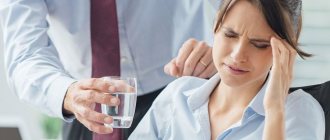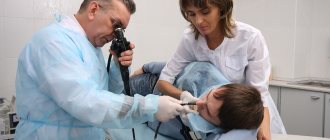Symptoms
Aggravated hemorrhoids manifest themselves as inflammatory processes, which cannot but affect the functioning of the digestive organs and other nearby anatomical structures. Pain is localized in different parts of the body, indicates complications, its nature depends on where the hemorrhoids are located - inside or outside.
The main symptoms are prolapsed nodes, constipation, pain and burning in the anus. These factors impair blood circulation, cause venous congestion, disrupt digestion, provoke pain, difficulty defecating, bloating, and gas formation.
Gradually, over several months or years, the disease progresses, the inflammatory processes worsen, the symptoms increase, and the hemorrhoids begin to prolapse more and more.
The strength of the pain depends on:
- the presence of hemorrhoidal cones and their location, internal or external;
- patient's pain threshold;
- the stage at which the disease is located.
And if at the early stage the pain syndrome is insignificant, manifests itself only during bowel movements and passes quickly, then at subsequent stages it intensifies even with coughing or sneezing.
Often the pain becomes unbearable, and the patient develops a panicky fear of bowel movement. It delays the moment, which causes even more constipation and problems with the intestines and stomach.
At this stage, accompanying symptoms appear: pulling in the lower abdomen, radiating to the tailbone and lower lumbar region, back pain.
The cause of the pain syndrome can only be determined by a proctologist, based on the main manifestations of hemorrhoids:
- feeling of discomfort in the anus, sensation of a foreign body;
- itching and burning in the perineum;
- the presence of blood or mucus in the stool;
- painful bowel movements;
- a feeling of fullness in the intestines even after going to the toilet.
All of the above is a serious reason to contact a specialist who will conduct appropriate diagnostics and prescribe adequate treatment based on its results.
Symptoms vary depending on the types of hemorrhoids.
- Internal . It develops slowly and does not have pronounced symptoms. It is characterized by protrusion of blood vessels inside the rectum as a result of increased blood flow. During this period, the patient's pain is localized in the lower abdomen, right side, and lower back. Diarrhea or constipation, bleeding from the anus, and a feeling of fullness in the intestines appear.
- External
. Hemorrhoidal cones come out. Also called anal hemorrhoids. Characterized by uncomfortable sensations and some inconvenience. In the initial form of the disease, the cones easily go inside on their own after bowel movement. On subsequent ones, they can be adjusted only by hand, and they can appear from the outside even with a slight load. Hemorrhoids radiate to the lower abdomen or tailbone. - Mixed
. The most severe, difficult to treat with medication. The main reason is neglect of one’s health, lack of adequate treatment and preventive measures. Combines signs of internal and external hemorrhoids.
Features of the disease and stage
Hemorrhoids are often compared to varicose veins in the legs. There are similarities between these diseases, the only difference is in localization. Hemorrhoids affect the anus area. Newly formed nodes complicate the act of defecation and cause a number of unpleasant sensations in the patient. These lumps can appear inside and outside the rectum.
Hemorrhoids are a disease that affects the veins in the anus or rectum
Over time, the pain becomes more intense, as the nodes expand significantly. The main cause of the disease is blood stagnation. There are 4 stages of hemorrhoids:
- first - a small amount of blood is released;
- second, knots fall out and need to be straightened out yourself;
- third - the loss of nodes becomes regular;
- fourth - it is impossible to move either hemorrhoids or the rectal mucosa into the anal canal.
This classification was developed in order to correctly select the treatment for each stage. Initially, conservative and sclerotherapy, infrared coagulation are prescribed. At the second stage, in addition to these methods, suture ligation and ligation with latex rings, as well as combined methods, can be used.
In more advanced situations, transanal resection of the mucosa is prescribed using the Longo method. It is possible to cure the disease through surgery. The last stage of the disease can only be cured through surgery.
What diseases can cause pain in the lower abdomen and lower back, except for hemorrhoids?
Varicose veins of the rectum make themselves felt towards the end of the second stage. The nodes fall out more often with the slightest physical exertion, movement, sneezing and defecation. The pain is concentrated mainly in the perineal area, although it can radiate to the lower abdomen and the right side of the groin. The lower back may also hurt.
In the absence of the main symptoms, pain can be caused by other diseases.
The lower abdomen may hurt if you suspect:
- cancer of the intestine, rectum;
- polyps, neoplasms in the large intestine;
- colitis, proctitis and paraproctitis, other inflammatory processes of an infectious and non-infectious nature;
- inflammation and exacerbation of prostatitis, prostate adenoma, prostate cancer in men;
- gynecological disease in women;
- anal fissures;
- inflammatory processes requiring surgical intervention - appendicitis, ectopic pregnancies;
- Crohn's disease;
- helminthic infestations.
Lower back pain is caused by:
- diseases of the spinal column - osteochondrosis of the sacrum and lower back, radiculitis, lumbago;
- pathologies of the genitourinary system and excretory tract - ureters and urethra;
- exacerbation of chronic prostatitis in men, uterine fibroids in women.
Only diagnostics and consultation with a specialist will help to accurately determine the subjective causes of the unpleasant sensations that appear and answer the question of whether hemorrhoids can radiate to the lower abdomen in this particular situation.
Characteristics of pain in the intestinal area
They can be of different nature.
It depends on the:
- presence of nodes;
- sensitivity of the human body;
- stage of the disease.
At the initial stage of the onset of the disease, pain may be insignificant, intensifying at the time of defecation. In addition, they are short-lived.
As hemorrhoids progress to a new stage, the pain in the intestines may intensify. It is acutely felt in the lower abdomen and rectum.
If severe pain occurs, a person feels unbearable discomfort, which intensifies at the time of defecation, straining, coughing, sneezing. As a result, insomnia may occur. In addition, the person’s psychological state is disrupted, which delays the recovery process during treatment.
How does the stomach hurt with hemorrhoids: characteristic signs and manifestations
Hemorrhoids may cause pain in the abdomen, lower back, other parts of the body, and internal organs located close to the anus and intestines.
Hemorrhoidal pain syndrome has its own differences and characteristics, with the help of which one can accurately say whether the painful sensations are associated with this particular ailment or with some other one.
How can your stomach hurt with hemorrhoids?
- The nature of the pain can be aching, constant, cramping, or sharp.
- Occur during defecation or a few minutes after.
- Increased pain occurs after prolonged sitting.
- It often radiates to the lower back or right side.
- They are always accompanied by bleeding from the anus during trips to the toilet, which is caused by a violation of the integrity of blood vessels with solid feces during constipation and causes sharp, often unbearable pain in the abdomen and groin area. Blood remains on the napkin even with cracks in the anus.
- They acquire a sharp pulse-like character with a strong inflammatory process and the formation of blood clots.
- Cramping pain occurs when hemorrhoids prolapse and the rectal lumen narrows.
- The pain becomes constant and debilitating when the disease is advanced and is no longer associated with bowel movements. Severe inflammatory processes can be caused by the addition of concomitant diseases - peritonitis, necrosis, etc.
Too large hemorrhoids are dangerous, they can lead to complete intestinal obstruction, become a source of infection, an open gate to any pathogenic microorganism. This is what happens due to a decrease in immunity during the course of the disease.
To complete the clinical picture, the main symptoms of hemorrhoids should be added - burning and itching in the perineum, bloating, gas formation, constipation, nausea and vomiting.
Methods of dealing with pain
General requirements
To remove the unpleasant feeling, it is advisable to perform the following activities.
- Relax. It is necessary to take a comfortable position to reduce pressure on the organs of the digestive system.
- Remove tight clothing that “pinches” knots. This will provide the muscles with the necessary position and help relieve spasms.
- Take antispasmodic medicine - Ibuprofen or Combispasm.
- Follow diet number 3.
- Use herbal decoctions with a laxative effect.
- Perform a peritoneal massage.
- To reduce acute abdominal pain due to hemorrhoids, you should perform an exercise. You need to spread your legs, slowly squat down and stay in this lower position for a few seconds.
- Take walks. This event will normalize intestinal activity and relieve unpleasant discomfort.
Drug treatment
It is imperative to carry out complex treatment, use suppositories, follow a regimen and diet.
Popular suppositories are drugs from the Relief group.
You can also use:
- Anestezol;
- Procto-Glyvenol;
- Proctosedyl;
- Proctosan;
- Ultraproct;
- Gepatrombin G.
For internal hemorrhoids, it is recommended to use venotonic drugs:
- Phlebodia 600;
- Detralex.
Before use, consultation with a proctologist is necessary.
Diet food
To alleviate the condition, you need to follow a diet. Nutrition should be aimed at normalizing blood flow in hemorrhoidal seals. To do this you will have to give up the following products:
- fatty, spicy and salty foods;
- alcohol;
- chocolate, strong tea and coffee;
- milk;
- rice;
- semolina;
- pasta;
- flour products;
- potato.
Such food is considered harmful. In addition, these products are low in fiber.
The treatment table must include fresh fruits and vegetables, herbs, which are a source of fiber. Such food helps normalize intestinal activity:
- grape;
- berries;
- beets;
- prunes;
- fish;
- oat bran;
- honey.
It is also necessary to consume more fermented milk products.
We must not forget about carrying out daily personal hygiene procedures.
Why does the lower abdomen and lower back hurt with hemorrhoids?
Hemorrhoids may not hurt immediately. This is its danger. The only way it can manifest itself is the appearance of nagging pain in the lower abdomen, indicating the appearance of internal nodes. But for now they are soft, elastic, do not get injured and do not bleed.
As the educational process increases, the main symptoms of the disease begin to appear. Their nature and strength depend on the patient’s condition, his age, pain threshold and other indicators.
The appearance of uncharacteristic pain associated with the disease does not always occur and is associated with the individual characteristics of the patient. They occur with hemorrhoids in:
- lower abdomen;
- left side;
- genital area;
- coccyx area;
- lower back.
There are several reasons why they arise.
Gastrointestinal tract disorders
- Inflammatory processes cause constipation, bowel movements occur at the wrong time. The stool hardens. When passing through the intestinal mucosa, they stretch its walls, which contributes to the appearance of pain in the lower abdomen.
- Injury to the mucous membrane and perineum by feces can cause anal fissures with the subsequent development of proctitis and fistulas, in which the pain radiates to the lower back and pulls the lower abdomen.
- With diarrhea, intestinal motility is disrupted, which causes discomfort in the abdominal cavity.
- Improper functioning of the gastrointestinal tract, disruption of metabolic processes causes gas formation and bloating. The intestinal walls become stretched, and a cramping pain syndrome similar to intestinal colic appears.
Radiation of pain
This is the process of spreading pain beyond the affected or inflamed organ as a result of the presence of many nerve endings in it.
The perineal area is one of these. Pain is easily transmitted along large nerves to neighboring organs located in the abdominal cavity. Hence the pain in the lower back, tailbone, and back.
Intestinal infection
Stagnation of feces causes disruption of microflora, penetration of infections and other pathogenic microorganisms, and provokes the occurrence of inflammatory processes. The painful syndrome in this case is abdominal in nature, that is, it appears in the navel area, in the upper middle part of the abdominal cavity or in its lower left section.
Psycho-emotional state
Often, when defecating with hemorrhoids, the pain is so intense that when remembering it, a person puts off going to the toilet, which only aggravates the situation and provokes long-term constipation and hardening of the stool.
The nervous system is at its limit, the patient complains of headaches and dizziness, insomnia and nausea.
The placebo effect occurs when, with the memory of an unbearable pain syndrome, a person begins to feel unpleasant symptoms in the abdomen, groin, tailbone and back.
Among women
At the early stage of hemorrhoids, nagging pain in the lower abdomen, a sensation of a foreign body and discomfort require additional examination, as they may be associated with problems in the genitourinary organs, gynecological pathologies - uterine fibroids, ovarian cysts, neoplasms of a malignant or benign nature.
Symptoms of hemorrhoids may intensify during menstruation, pregnancy, childbirth and anal sex.
The loss of hemorrhoidal cones at stages 2 and 3 of the disease requires a visit to the gynecologist, as it can cause the appearance of gynecological diseases.
In men
Just like in women, the first signs of pain in the lower abdomen or lower back may indicate the onset of inflammatory processes in the genitourinary organs - prostatitis and cystitis. You need to contact a urologist.
In later stages of hemorrhoids, the nodes become visually visible or palpable during rectal examination, which confirms the pathology.
Damage to nodes
Hemorrhoids are accompanied by constipation. The stool hardens, inflammation has occurred - when it comes out, it scratches the thin walls. In the external form, it occurs during exit; in the internal form, it occurs when passing through the channel. The pain spreads throughout the pelvic region and internal organs.
Causes of discomfort:
- Injuries to the intestines and mucous membranes are a common cause.
- Pain tends to be transmitted along the nerve endings connecting the pelvic organs. The neighboring parts begin to ache and ache. This is innervation.
- Contact with a diseased area (with stagnation of feces in the intestines) – organs with chronic diseases, an old form of the disease, begin to ache. Let's take sexual actions as a basis. Women will feel pain in the back, sacrum, tailbone, and lower abdomen. In men, it occurs during urination.
With the internal form of the disease, the lower abdomen pulls. Other parts of the body - tailbone, lower back, back - suffer from hemorrhoids less often. The anus is subject to problems with external hemorrhoids; aching sensations are acceptable in the abdomen and other parts of the body. The intestines suffer first.
Localization of pain
Lower back pain
If lower back pain is associated with hemorrhoids, then it is quite severe. This is due to the presence of a large number of nerve endings in the perineum. With a strong inflammatory process in the rectum, painful sensations move to the lower spine. Usually during this period the patient already experiences unbearable torment, which does not allow him not only to walk, but also to lie down, so he is forced to take painkillers.
Pain in the tailbone
Usually it is not the tailbone that hurts; it has no nerve endings. Pain is often associated with injuries to the pelvic bones or their pathologies, or wearing tight clothing.
With hemorrhoids, it can radiate to this area during complications - paraproctitis, perineal cracks, fistula formation.
Back pain
Most often caused by problems with the musculoskeletal system. Only after excluding such pathologies should you consult a proctologist. Painful sensations in the back during an exacerbation of hemorrhoids most often begin when the patient does not change position often and for a long time.
Treatment of the disease and accompanying pain
Before starting treatment, the patient must undergo an examination to determine the exact cause of the pain. The results of all studies will become the basis for selecting an appropriate treatment method. This process is characterized by taking into account the individual characteristics of the organism.
Good Kegel exercise
To get rid of it, a combination treatment is used, consisting of:
- Preventive measures. Prevention is of great importance in getting rid of all diseases. For hemorrhoids, the following measures are used:
- change of type of activity (if the work involves being in one position for a long time);
- diet adjustments. It should include products that ensure normal digestion and prevent constipation;
- regular therapeutic exercises. It represents a compromise between full-fledged sports training and its complete absence. It is prescribed in case of necessary limitation of excessive physical activity and ensuring its required level;
- compliance with the required hygiene measures.
Painful sensations arising from the irradiation process will subside if the damaged surface is not irritated. Therefore, it requires regular disinfection. This is done using wet wipes or by washing the anal area after each bowel movement.
- Use of medications. Medicines for the treatment of internal appearance may be in the form of suppositories for rectal use. Their dosage and duration of use are determined by the attending physician. Most often, rectal suppositories from the group of homeopathic drugs are recommended for use.
The easiest way is to use suppositories. To get rid of painful sensations, use special ointments, gels or creams that are suitable for an internal diagnosis. We must not forget about tablet forms of drugs. They have all the necessary actions, but have serious side effects and contraindications.
- Use of minimally invasive procedures. These include manipulations used at the onset of the disease, since during this period of time they give the greatest effect. These include: electrolytic and infrared coagulation, cryotherapy, ligation using special latex rings and massage.
- Traditional medicine methods. This method of treatment involves the use of homemade candles, ointments and baths based on herbal ingredients, which are done in a sitting position.
- Surgical intervention. This radical treatment method is used in most cases when all of the above points are ineffective. The operation provides a guarantee for 3–5 years.
How to eliminate pain
Regardless of where the pain of hemorrhoids is localized, a person tries to get rid of it first.
In this situation, suppositories for local therapy are excellent. It is advisable to leave them overnight. Pre-wash and dry the anal area. The candles that proved to be most effective were:
- Relief;
- Hepatrombin G;
- Proctosedyl;
- Ultraproct;
- Anestezol;
- Proctoglivenol.
Suppositories with sea buckthorn oil or ichthyol will cope perfectly with pain and other unpleasant symptoms.
To relieve inflammation and swelling, you can use venotonics - Phlebodia 600 or Detralex.
Internal hemorrhoids: conservative and surgical treatment methods
Treatment of internal hemorrhoids is a rather difficult task, since most patients seek help only when complications arise. During this period, surgical intervention has to be performed, whereas in the initial stages conservative therapy is effective. Let's look at the methods of treating internal hemorrhoids in more detail.
Drug therapy
Among the medications, local and systemic drugs can be distinguished. For internal hemorrhoids, treatment with suppositories and microenemas allows you to create the desired concentration of the active substance at the destination and at the same time avoid many adverse reactions. Systemic medications are more often used to treat complications, such as bleeding from hemorrhoidal veins or anemia.
Medicines for hemorrhoids are most often used in the form of suppositories.
Minor Factors
Can there be pain in the lower abdomen due to hemorrhoids? This manifestation is only one of the signs of inflammation of the rectum. Along with hemorrhoids, there are a number of pathologies and conditions that cause nausea and pain below the navel. Among them the following are most often distinguished:
- Inflammation of the uterus and its appendages, occurring against a background of nausea and flatulence. Girls and women suffer.
- Patients are concerned about frequent episodes of constipation, flatulence or diarrhea.
- Inguinal hernia strangulation. Accompanied by sharp and severe pain.
- Appendicitis. With it, the pain increases, the stomach begins to swell.
- Urolithiasis, which is characterized by the presence of painful episodes in the lumbar area. In this case, the back is one of the first to be affected.
In many cases, the pain radiates to the leg, affecting the patient’s movement. Pain in the abdomen or discomfort in the lower back is a frequent, but not obligatory, accompaniment of hemorrhoids. Such manifestations may indicate the occurrence of internal nodes. In this case, the pain does not depend on the bowel movement itself. The pain syndrome is constant and aching in nature.
Only timely therapy can minimize the pain symptoms of the disease. When stagnant processes are eliminated, the body’s recovery occurs quickly, the patient will almost immediately feel relief: the pain does not go anywhere. Such therapy will free a person from pain, bloating and bleeding. Normalizing the condition will to some extent prevent the appearance of new lumps, nodes, and bulges. Complex therapy helps to ensure that your back and stomach no longer hurt.
Causes of pain in the lower abdomen
Unfavorable factors that provoke this manifestation may look like this:
- reflex and psychosomatic problems;
- colonic irritability syndrome, when during an inflammatory process inside the rectum, a nearby section of the intestine reacts to it;
- interruptions in peristalsis in the colon, when it accelerates, causing diarrhea, or slows down, causing constipation (these conditions can replace one another);
- anal fissures;
- dysfunction of the gastrointestinal tract (inflammatory pathologies can provoke pain in the lower abdomen);
- diseases of the heart and blood vessels associated with the outflow of blood (in this case, the patient may initially feel pain in the lower abdominal cavity or in the chest, only after which signs of hemorrhoids will begin to appear).
In men
In representatives of the stronger sex, the cause of such discomfort may be hidden, in addition to the above-mentioned reasons, in other diseases. This part of the abdomen feels pain when the genitourinary system is disrupted. If you have prostatitis or other diseases, sharp painful spasms may appear. A sedentary lifestyle and poor nutrition also provoke discomfort.
Possible reasons
Frequently occurring dull pain is a sign of the development of chronic diseases
Why do these symptoms appear? The causes of abdominal pain are varied. Short-term pain from excitement, pregnancy or simple indigestion is often taken for granted and quickly passes. A periodically occurring painful syndrome usually indicates a serious chronic disease.
The main diseases characterized by constant pain:
- irritable bowel syndrome;
- Crohn's disease (chronic intestinal inflammation);
- inflammation of diverticula in the intestinal walls (occurs in old age and with the abuse of heavy fatty foods);
- colitis (inflammation in the colon);
- benign and malignant tumors;
- diseases of the rectum;
- damage to the urinary tract and kidneys.
What are the symptoms of hemorrhoids?
If you have varicose veins of the rectum, then pain and discomfort are not always located strictly in the anus.
Often the patient feels a whole range of negative sensations in the stomach: severe bloating, pain in the lower abdomen, and constipation brings him considerable inconvenience. The patient notices that the rubber inserts of the underwear somehow feel a noticeable pressure in the waist area. And most importantly, there was a feeling of the presence of a foreign body in the rectal canal.
Usually one symptom appears, then another, and then they all combine into one negative complex. Then the person feels pain and slight tingling in the anus area. Finally, he realizes that the pain from hemorrhoids has even spread to the abdominal area.
Sometimes the pain radiates to the lower back, to the limbs, and the proctologist’s potential patient may not even associate these lumbagos with hemorrhoids.
But, of course, one should not think that only varicose veins of the anal venous plexuses lead to such signs: other proctological problems and gynecological ailments can cause such undesirable phenomena.
Finally, problems of the digestive tract often cause pain in the lower abdomen. But if you are diagnosed with hemorrhoids and have pain in the abdominal area, these things can certainly be interrelated.
But still, hemorrhoids are, first of all:
- Rectal bleeding (minimal at first, but as the disease progresses it becomes more severe);
- Discomfort and itching in the anus;
- Soreness in the same area;
- Prolapse of the venous plexuses from the rectum.
In order not to frighten yourself with pictures of complications and fatal consequences that every second patient “pictures” in his head, you need to go to a coloproctologist and ask him if your stomach can hurt with hemorrhoids.










